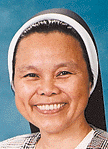

![]()
View Point


![]()
View Point
I am an ardent supporter of the canonization cause of blessed Damien DeVeuster and was privileged to have been one of five persons presenting gifts to our Holy Father, Pope John Paul II, at Damien's beatification in Belgium in 1995. Damien film
contained factual errorsThus, it was more than a delight to hear that movie companies are presenting his story and that one film, directed by Paul Cox, has become a reality.
After being in the audience for the ERA Film & Kinepolis Group Production, I have concluded that "Molokai: The Story of Father Damien" will do much to make the sacrifice of Blessed Damien better known and cherished.
Yet, being well acquainted with the Damien story, I also know that the film contains misleading inaccuracies, despite it being called a biography. These inaccuracies are graver than those usually allowed with "dramatic license."
I want to correct the record in a few important respects, especially by listing some misrepresentations of Mother Marianne Cope and correcting some details of her life:
The film shows a badly afflicted Damien stricken with leprosy going to help patients who were being maltreated in the harbor. Mother Marianne supposedly read about this incident and came to Hawaii.
In real life, a robust Damien met Mother Marianne and her companions soon after their arrival in Honolulu in late 1883. His leprosy was not tested and affirmed until 1885. The sisters had come to Hawaii in response to an appeal from King Kalakaua for sister-nurses, especially those to aid patients afflicted with leprosy.
In the film Joseph Dutton tells Damien there is bad news in that a lot of money he was hoping for would be used to build a hospital in Honolulu and there is good news in that nuns are coming from Syracuse, N.Y.
In real life Dutton, Damien's helper, could hardly have announced the coming of the Franciscan sisters. He arrived in Hawaii in 1886, whereas the sisters had arrived in 1883. The hospital that allegedly would take money coming to Damien already was in existence, and was a rat-infested, filthy place until the sisters cleaned it up. There were no plans for a new one.
The film gives the viewer the impression that the nuns had only the lightly afflicted leprosy patients whereas Damien worked under the worst conditions with a thousand patients.
In real life, the sisters' hospital in Honolulu was full of patients under their personal care. At the Molokai settlement, its 653 residents in 1886 were not all under the care of Father Damien, and all were not ready for hospitalization. Upon arrival the sisters found that there were heavy and light cases at the hospital. The deportation policy for most patients was on hold until late 1887, while the Board of Health was studying a different placement system for care.
In the film Damien is told by Dutton that Damien is banned from entering the sisters' convent.
In real life, according to Mother Marianne's journal, she was regretful that Damien would come to visit her at Bishop Home in Kalaupapa but refused to enter the sisters' convent because of his leprosy.
In the film Mother Marianne makes almost a last-moment dramatic first appearance at Damien's bedside. She proceeds to apologize for her tardiness in coming to Molokai and asks for forgiveness.
Damien was a dying man but not yet incapacitated when Mother Marianne arrived at Kalaupapa. Records show that he welcomed the sisters the same day of their arrival to Kalaupapa on Nov. 14, 1888. He came several times to Kalaupapa to visit with Mother Marianne, and she visited him at Kalawao. Certainly she did not arrive with an apology.
Sister Davilyn Ah Chick is St. Francis School's
director of development.